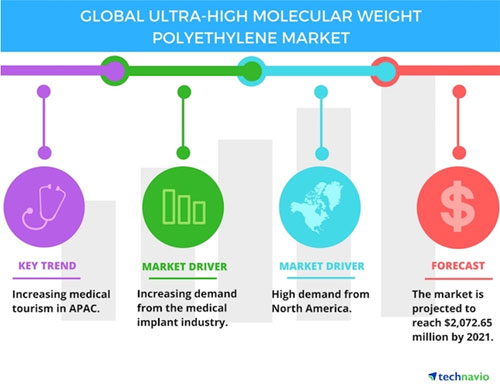|
Medical
Implants Drive Growing Demand For
Ultra-High Molecular Weight Polyethylene
Demand for ultra-high molecular
weight polyethylene (UHMWPE) for the fabrication of orthopedic and
cardiovascular implants is driving growth for the material in global markets,
according to a report from Technavio (London). The study projects a compound
annual growth rate of more than 9% during the 2017 to 2021 forecast period.
UHMWPE is an odorless, tasteless
and nontoxic polyethylene (PE). It has all the characteristics of high-density
PE, but with the added advantage of being resistant to acids, alkalis and other
organic solvents, according to Technavio. UHMWPE is available in many shapes and
forms, making it suitable for a range of applications, but the medical segment
is one of the primary markets, accounting for almost 30% of market share in
2016. The other leading applications are protective apparel and gear and
rechargeable batteries.

UHMWPE-based implants have gained
popularity in applications such as orthopedic and cardiovascular implants, notes
the report, because of the material’s long life span and tensile strength. In
cardiovascular devices, UHMWPE fibers are gradually replacing polyethylene
terephthalate fibers owing to their small size and flexibility, explains Mohd
Shakeel Iqbal, a lead plastics, polymers and elastomers research analyst at
Technavio. “The types of UHMWPE-based cardiovascular implants are cardiac stents,
pacing devices and structural cardiac implants. In addition, the advances in
medical technologies, increasing healthcare investments, an aging population and
[growing] disposable income” are driving demand for UHMWPE in medical
applications, said Iqbal.
The material has a long history
of use in protective gear starting with WWII, and it continues to be a popular
application. UHMWPE-based hard ballistic fibers are used in helmets and body
armor, while soft ballistic fibers are used in vests to protect soldiers from
the impact of knives and bullets.
A newer application involves
rechargeable batteries, where UHMWPE is widely used as a separator. Demand is
especially high in North America, according to Technavio. Separators made from
UHMWPE offer a microporous texture, small aperture and enhanced rejection rate,
which are crucial for the performance of batteries in the automotive industry in
North America.
For a free sample report or to
purchase the full study, go to the Technavio website.
https://www.plasticstoday.com/medical/medical-implants-drivegrowing-demand-ultra-high-molecular-weight-polyethylene/124849842957645
* * * * *
|

